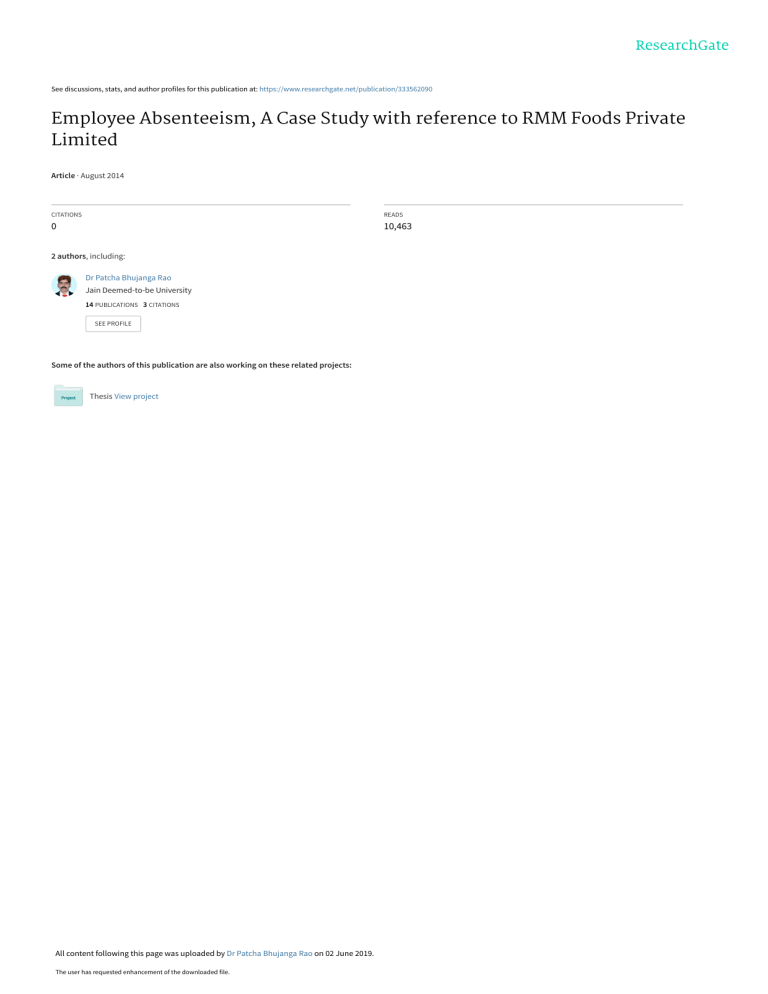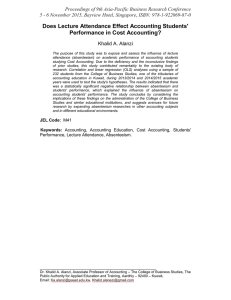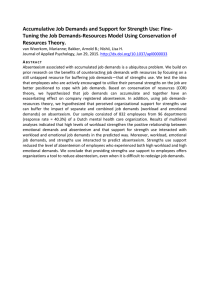
See discussions, stats, and author profiles for this publication at: https://www.researchgate.net/publication/333562090 Employee Absenteeism, A Case Study with reference to RMM Foods Private Limited Article · August 2014 CITATIONS READS 0 10,463 2 authors, including: Dr Patcha Bhujanga Rao Jain Deemed-to-be University 14 PUBLICATIONS 3 CITATIONS SEE PROFILE Some of the authors of this publication are also working on these related projects: Thesis View project All content following this page was uploaded by Dr Patcha Bhujanga Rao on 02 June 2019. The user has requested enhancement of the downloaded file. Employee Absenteeism, A Case Study with reference to RMM Foods Private Limited Dr. Patcha Bhujanga Rao Associate Professor, Department of MBA, Sreenivasa Institute of Technology and Management Studies, Chittoor Prof.pbr@gmail.com ABSTRACT Anecdotal information suggests that the increase in employee absenteeism has been a growing concern to employers. Absenteeism results in financial losses both because of the resultant reduction in productivity and the costs of sick leave benefits paid as wages for no work. This project on Employee Absenteeism reveals that one of the major problems is absenteeism. Absenteeism is the practice or habit of being an absentee and an absentee is one who habitually stays away from work. Employees Absenteeism is a serious problem for management because it involves heavy additional expenses. Absenteeism hinders planning, production, efficiency and functioning of the organization. In fact high rates of absenteeism affect an organization state of health and also supervisory and managerial effectiveness. Key Related Terms: Employee absenteeism, Performance, Employers, Employees INTRODUCTION Absenteeism is a habitual pattern of absence from a duty or obligation. Traditionally, absenteeism has been viewed as an indicator of poor individual performance, as well as a breach of an implicit contract between employee and employer, it was seen as a management problem, and framed in economic or quasi-economic terms. More recent scholarship seeks to understand absenteeism as an indicator of psychological, medical, or social adjustment to work. High absenteeism in the workplace may be indicative of poor morale, but absences can also be caused by workplace hazards or sick building syndrome. Many employers use statistics such as the Bradford factor that do not distinguish between genuine illness and absence for inappropriate reasons. As a result, many employees feel obliged to come to work while ill, and transmit communicable diseases to their co-workers. This leads to even greater absenteeism and reduced productivity among other workers who try to work while ill. Work forces often excuse absenteeism caused by medical reasons if the worker supplies a doctor's note or other form of documentation. Sometimes, people choose not to show up for work and do not call in advance, which businesses may find to be unprofessional and inconsiderate. This is called a "no call, no show". According to Nelson & Quick (2008) people who are dissatisfied with their jobs are absent more frequently. They went on to say that the type of dissatisfaction that most often leads employees to miss work is dissatisfaction with the work itself. The psychological model that discusses this is the "withdrawal model", which assumes that absenteeism represents individual withdrawal from dissatisfying working conditions. This finds empirical support in a negative association between absence and job satisfaction, especially satisfaction with the work itself. Medical based understanding of absenteeism find support in research that links absenteeism with smoking, problem drinking, low back pain, and migraines. Absence ascribed to medical causes is often still, at least in part, voluntary. Research shows that over one trillion dollars is lost annually due to productivity shortages as a result of medical-related absenteeism, and that increased focus on preventative wellness could reduce these costs. [3] The line www.theinternationaljournal.org > RJSSM: Volume: 04, Number: 04, August 2014 Page 224 between psychological and medical causation is blurry, given that there are positive links between both work stress and depression and absenteeism.[2] Depressive tendencies may lie behind some of the absence ascribed to poor physical health, as with adoption of a "culturally approved sick role". This places the adjective "sickness" before the word "absence", and carries a burden of more proof than is usually offered. Evidence indicates that absence is generally viewed as "mildly deviant workplace behavior". For example, people tend to hold negative stereotypes of absentees, under report their own absenteeism, and believe their own attendance record is better than that of their peers. Negative attributions about absence then bring about three outcomes: the behavior is open to social control, sensitive to social context, and is a potential source of workplace conflict. Thomas suggests that there tends to be a higher level of stress with people who work with or interact with a narcissist, which in turn increases absenteeism and staff turnover. PROBLEM AFFIRMATION Employee presence at work place during scheduled time is highly essential for the smooth running of production process in particular and the organization in general, despite the significance of employee presence, employee sometime fail to report at work place during scheduled time, which is known as absenteeism. Absenteeism at the operative level is a crucial problem in industries. The study of absenteeism is very important because excessive absenteeism tells upon the productivity of organization during periods when the production is at peak and skilled labor is scarce, the absence of employees will be very much disruptive to production and morale. Excessive absence involves a considerable loss to the organization because work schedule are upset and delayed, the management has to give the overtime wages to meet the delivery dates. Thus, it is necessary to determine its extent and causes to minimize the absenteeism. To facilitate this, proper investigation should be made from every department in the organization for various causes of absenteeism by such division as age, sex, days of the week and classes of job. Hence, the need for investigation into absenteeism has become a dire need rather than academic interest. As such, the present study is undertaken to minimize the absenteeism concentrating on the attributes such as sickness, accidents, poor control, lack of interest and attitude OBJECTIVES OF THE STUDY 1. To identify the reasons for absenteeism of employees in RMM Food Products Private Limited. 2. To assess the reasons for absenteeism and its impact on work and working environment in RMM Food Products Private Limited. 3. To review the variables that reduces the rate of absenteeism and suggest measures to minimize absenteeism in RMM Food Products Private Limited. REVIEW OF LITERATURE The problem of poor attendance includes Absenteeism / tardiness. Poor attendance can became a serious problem that leads to discharge for just cause. If poor attendance are forced to increased their efforts to compensate for people who shrink their responsibilities. Sometimes employee are absent or tardy for legitimate reason example sickness, childcare Problems , inclement , weather , or religious beliefs .managers should identify those employees who have legitimate reasons and threats the differently than they treat those who are chronically absent or tardy . When discipline an employee for poor attendance, manager need to consider several factors managers should be aware of patterns of poor attendance within a work unit. Systematic absenteeism or tardiness may be symptom of job avoidance. Employee may dread coming to work because co-worker are unpleasant, the job has become unchallenging they are piercing conflicting demands from job and family (or) the supervision is poor. A disciplinary approach is not the best www.theinternationaljournal.org > RJSSM: Volume: 04, Number: 04, August 2014 Page 225 way to deal with this type of absenteeism. It would be better for the manager (or) company to look for ways to change the work environment possible solutions to job avoidance are designing jobs or, when the problem is widespread, restricting the organization. Causes of absenteeism: 1.Serious accidents 2.Low morale. 3.Lack of Job satisfaction 4.Boredom of the job 5.Poor working conditions 6.Transportation problems 7.Stress 8.Lack of satisfaction from present work. 9.Poor welfare facilities1. While an employer may find that the overall absenteeism rate and cost are within an acceptable range, it is still advisable to study the statistics to determine whether there are patterns in the data. Rarely does absenteeism spread itself evenly across an organization. It is very likely that employees in one area may have nearly perfect attendance records, while others in a different area may be absent frequently2. The following are general causes of absenteeism. Maladjustment with the working conditions: If the working conditions of the company are poor, the workers cannot themselves with the companies’ working condition. Social and religious ceremonies: Social and religious function diverts worker attention from the work Unsatisfactory housing conditions: This is caused at work place. Poor welfare facilities, unhealthy working conditions Absenteeism among workers in our factories in the manufacturing sector in most part of India has been for a major problem for a long time .In its extreme from as many as40%(or) more workers may not present themselves for work in a particular shift (or) in a particular day in a particular department, causing the severe disruption of production schedules .Low output in one department then has a chain reaction down the line. The monthly average for the whole factory would however between 10%to35percent the peaks varying from factory to factory. Considerable research on absenteeism has taken place in the western countries and the primary theme highlighted is that the problem is caused by the prevailing climate at the workplace. They also switched onto incentives for better attendance .In the 1992, encashment of leave was introduced and in mid 1996 the cash attendance incentive on monthly basis came in a part of an overall settlement with the union. In our country the faith in cause and effect relationship tends to be rather weak, and thus the search for root cause is not persevered. In shows that those employees who have low job satisfaction tend to be absent .The connection is not always sharp, for a couple of reasons, first, some absences are caused by legitimate medical reasons therefore a satisfied necessarily plan to 1 David B .Balkin (2001) , Prentice-Hall Pvt., Ltd., 3rd Edition, New Delhi, pp477-478 George Bohalander and Vienna Vera (2010),1st Edition, Engage Learning India Pvt., Ltd, Australia, pp.97-100 2 www.theinternationaljournal.org > RJSSM: Volume: 04, Number: 04, August 2014 Page 226 be absent ,but they to be find it easier to respond to the opportunities to do so .These voluntary absences often occur with frequency a certain cluster of employee and usually occur on Mondays or Fridays .Where involuntary (medically related) absenteeism can sometimes be predicated (e.g. for surgery ) and often be reduced through the use of record checks ,different approaches are needed for absences caused by poor attitudes. HYPOTHESES 1. There is no significant difference of opinion between superior and subordinate employees with regard to the attributes that result in absenteeism among employees in RMM Food Products Private Limited. 2. There is no significant difference of opinion between male and female employees with regard to the attributes that result in absenteeism among employees in RMM Food Products Private Limited. 3. There is no significant difference of opinion between below 40 years and above 40 years of age with regard to the attributes that result in absenteeism among employees in RMM Food Products Private Limited. 4. There is no significant difference of opinion between 0-10 years, 10-20 years and above 20 years of service with regard to the attributes that result in absenteeism among employees in RMM Food Products Private Limited. DATA COLLECTION PRIMARY SOURCES Responses collected with the help of the questionnaire administered to the employees and management of, is the main primary source of data for this research work. The primary data are collected in three phases. In the first phase, the purpose and objectives of study are explained to them and requested to go through the schedule thoroughly. In the second phase doubts of the respondents about the contents of the schedule, if any are clarified. In the third phase, the filled in schedules are collected from the respondents by holding further discussions to elicit additional information. SECONDARY SOURCES The secondary sources of data are collected from the magazines, journals, bulletins, web sites and annual reports, etc., published by the organization. In addition to these, several structured interviews, and unstructured interviews, have also been conducted with experts on the subject and also a number of persons who are connected in one way or other, either directly or indirectly to know about absenteeism. SAMPLE FRAME The sample size was put to 120 chosen from various functional areas of the organization. The departments are first divided into strata and thus simple random sampling has been followed to select employees. TOOLS FOR DATA COLLECTION The questionnaire with a set of questions was constructed and administered to the sample of employees to elicit first hand information relating to the role, implementation, and perceptions of employees with regard to the absenteeism in RMM Food Products Private Limited. TOOLS FOR ANALYSIS www.theinternationaljournal.org > RJSSM: Volume: 04, Number: 04, August 2014 Page 227 The interview schedule method is used for gathering data, which are relevant for the study conducted among various categories of employees RMM Food Products Private Limited. The data collected through the schedules from primary sources have been processed and the results are analyzed by applying appropriate statistical tools. LIMITATIONS OF THE STUDY The questionnaire used for the purpose of collecting the opinions of employees has the following limitations. 1. Certain terms used for the purpose of the study are new to the respondents as they are not in general use. 2. In the process of data collection some of the respondents have expressed difficulty in answering the schedule. 3. The present study is confined to a sample of employees RMM Food Products Private Limited. ANALYSIS OF THE STUDY HYPOTHESIS 1: There is no significant difference between superior and subordinate employees with regard to absenteeism in RMM Food Products Private Limited. S.NO Variables No. of Respondents Mean (SD) Mean Difference @ 95% CI p-value p<0.0001 1 61.97 (4.86) 0.89 2 59.69 Subordinate 90 (3.33) 0.35 0.0048 The two-tailed P value equals to 0.0048.The mean of Superior minus Subordinate equals 2.28, 95% confidence interval from 0.71 to 3.85, t = 2.8718, df = 118, standard error of difference = 0.793, shows that the by conventional criteria, this difference is considered to be very statistically significant. Superior 30 HYPOTHESIS 2: There is no significant difference between male and female employees with regard to absenteeism in RMM Food Products Private Limited. S.NO Variables No. of Mean(SD) Mean p-value Respondents Difference @ p<0.0001 95% CI 1 Male 96 60.63 (3.33) 0.34 2 Female 24 60.83 (5.56) 1.14 0.8136 The two-tailed P value equals 0.8136. The mean of Male and Female equals 0.21, 95% confidence interval of this difference is from -1.95 to 1.54, t = 0.2362, df = 118, standard error of difference = 0.882 , shows that by conventional criteria, this difference is considered to be not statistically significant. www.theinternationaljournal.org > RJSSM: Volume: 04, Number: 04, August 2014 Page 228 HYPOTHESIS 3: there is no significant difference between below 40 years and above 40 years of age employees with regard to absenteeism in RMM Food Products Private Limited S.NO Variables No. of Respondents Mean(SD) Mean p-value Difference @ p<0.0001 95% CI 1 Below 40 75 60.51(3.83) 0.44 2 Above 40 45 60.84 (3.95) 0.59 0.6444 The two-tailed P value equals 0.644. The mean of Below 40 minus Above 40 equals -0.34, 95% confidence interval of this difference if from -1.78 to 1.11, t = 0.4627, df = 118, standard error of difference = 0.730 shows that by conventional criteria, this difference is considered to be not statistically significant. HYPOTHESIS 4 :there is no significant difference between degree/diploma and pg/professional qualification employees with regard to absenteeism in RMM Food Products Private Limited S.NO Variables No. of Respondents Mean (SD) Mean Difference @ 95% CI p-value p<0.0001 1 Degree/ 60.35 Diploma 113 (3.43) 0.32 2 PG/ 65.43 Professional 7 (7.07) 2.67 0.0006 The two-tailed P value is less than 0.0006. The mean of Degree/Diploma minus PG/Professional Qualification equals -5.08, 95% confidence interval of this difference is from -7.94 to -2.23, t=3.5254, df=118, standard error of difference=1.442, shows that by conventional criteria, this difference is considered to be extremely statistically significant. HYPOTHESIS 5: There is no significant difference between 0-10 and 10-20 years of service of employees with regard to absenteeism in RMM Food Products Private Limited S.NO Variables No. of Respondents 1 0-10 75 10-20 45 2 Mean (SD) 60.43 (3.97) 61.04 (3.63) Mean Difference @ 95% CI p-value p<0.0001 0.46 0.54 0.3961 The two-tailed P value equals 0.3961. The mean of Male minus Female equals -0.62, 95% confidence interval of this difference is from -2.05 to 0.82, t=0.8517, df=118, standard error of difference=0.725, shows that by conventional criteria, this difference is considered to be not statistically significant. FINDINGS 1. There seems to be a significant difference of opinions on absenteeism between superior and subordinate employees. 2. There is no significant difference of opinion between male and female employees regard to absenteeism 3. There is no significant difference of opinion between below 40 and above 40 years of age employees regard to absenteeism www.theinternationaljournal.org > RJSSM: Volume: 04, Number: 04, August 2014 Page 229 4. There seems to be a significant difference of opinion between degree/diploma and PG/Professional employees regard to absenteeism 5. There is no significant difference of opinion between 0-10 years and 10-20 years of service employees regard to absenteeism CONCLUSION It has been found that there is a significant difference of opinions between superior and subordinate employees with regard to the factors that lead to absenteeism. There seems to be an extremely significant difference between degree/diploma and pg/post-graduation employees with regard to absenteeism. The overall study with regard to absenteeism indicates that there is low absenteeism in the organization and the organization seems to be successful in adopting the measures to reduce employee absenteeism REFERENCES 1. Wayne F. Cascio (1986), Tata Mc Graw Hill Publications, 6th Edition, New Delhi. 2. David B .Balkin (2001) , Prentice-Hall Pvt., Ltd., 3rd Edition, New Delhi. 3. George Bohalander and Vienna Vera (2010),1st Edition, Engage Learning India Pvt., Ltd, Australia. 4. The Capacity Project. 2009. “What about the health workers?” Improving the work climate at rural facilities in Kenya. Voices from the Capacity Project, no. 27. Chapel Hill,NC:The Capacity Project. http://www.capacityproject .org/images /stories /Voices/voices_27.pdf(accessed March 15, 2012). 5. Dobalen, Andrew, and Waly Wane. 2008. Informal payments and moonlighting in Tajikistan's health sector. Policy Research Working Paper 4555. Washington, DC: The World Bank. http://papers.ssrn.com/sol3/ papers .cfm ? abstract _id=1106044 (accessed February 8, 2012). 6. Doerr, Rick. 2012. Utilizing mobile money in healthcare. ICT4Development: Global Broadband and Innovations. Washington, DC: USAID. http://gbiportal .net / 2012 / 01/27/utilizing-mobile-money-in-healthcare/ (accessed March 15, 2012). 7. Hilhorst, T., D. Bagayoko, D. Dao, E. Lodenstein, and J. Toonen. 2005. Building effective local partnerships for improved basic social services delivery in Mali. Amsterdam, the Netherlands: Royal Tropical Institute (KIT) and Bamako, Mali: SNV. http://www. kit. nl/ net /KIT _ Publicaties _output/ShowFile2.aspx?e=871 (accessed March 15, 2012). 8. Hsiao, William C., and Peter S. Heller. 2007. What macroeconomists should know about health care policy. Washington, DC: International Monetary Fund. http://apin.harvard.edu/health-care-financing/files/hsiao_2007_what_ macroeconomists_should_know_about_health_policy.pdf (accessed March 6, 2012). 9. Kiwanuka, Suzanne N., Alison A. Kinengyere, Christine Nalwadda, Freddie Ssengooba, Olico Okui, and George W. Pariyo. 2010. Effects of interventions to manage dual practice (protocol). Cochrane Database of Systematic Reviews 3. http://www.who.int/alliance-hpsr / projects / alliancehpsr_sruganda_kiwanuka.pdf (accessed February 7, 2012). 10. Institute of Policy Analysis and Research (IPAR). 2008. Absenteeism of health care providers in Machakos District, Kenya. IPAR Policy Brief 12, no. 2. http://www.docstoc.com/docs/69200071/Absenteeism-of-Health-Care-Providers-inMachakos-District--Kenya (accessed February 8, 2012). 11. Lewis, Maureen, and Gunilla Pettersson. 2009. Governance in health care delivery: Raising performance. Policy Research Working Paper 5074. Washington, DC: The World Bank. http://www-wds.worldbank.org / external / default /WDSContentServer /IW3P/IB/2009/10/13/000158349_20091013151915/Rendered/PDF/WPS5074.pdf(accessed February 7, 2012). www.theinternationaljournal.org > RJSSM: Volume: 04, Number: 04, August 2014 Page 230 12. Macq, Jean, Paulo Ferrinho, Vincent De Brouwere, and Wim Van Lerberghe. 2001. “Managing health services in developing countries: Between the ethics of the civil servant and the need for moonlighting: Managing and moonlighting.” Human Resources for Health Development Journal (HRDJ) 5, no. 1-3. http://www.who.int/hrh/en/HRDJ_5_03.pdf (accessed February 8, 2012). 13. Matsiko, Charles Wycliffe. 2011. Absenteeism in Uganda: Quantifying the nature and extent of absenteeism rates at the district level. Kampala, Uganda: IntraHealth International. 14. World Health Organization (WHO). 2006. The world health report 2006: Working together for health. Geneva, Switzerland: World Health Organization. http://www.who.int/whr/2006/en/ (accessed February 8, 2012). www.theinternationaljournal.org > RJSSM: Volume: 04, Number: 04, August 2014 View publication stats Page 231



